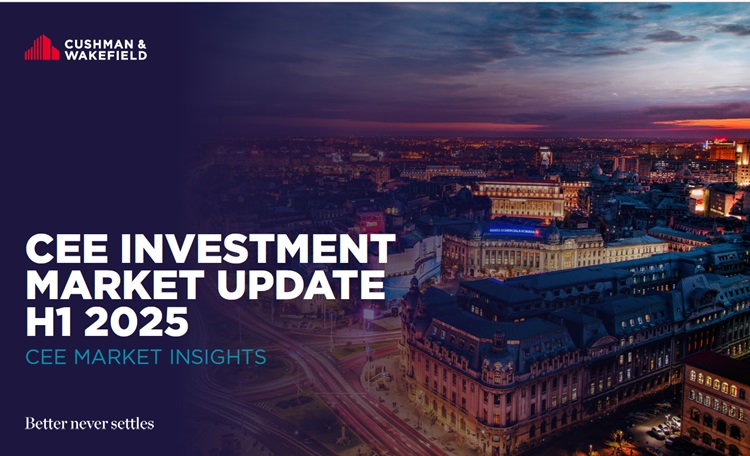-
The Czech Republic recorded a 187% year-on-year increase in commercial real estate investment, reaching a total of EUR 2.08 billion in the first half of 2025.
-
Total investment volume in the CEE region reached EUR 5.36 billion, representing a 51% year-on-year increase, with Slovakia posting a record growth of 315%.
-
While Poland remains a major player with EUR 1.71 billion in volume, its market has stabilized with a 5% decline compared to the previous year.
The commercial real estate (CRE) market in Central and Eastern Europe (CEE) continues its dynamic growth. According to the latest report by real estate consultancy Cushman & Wakefield, total investment volume in the first half of 2025 reached EUR 5.36 billion, marking a 51% year-on-year increase. In comparison, Western Europe saw only a 5% increase during the same period, with total investment volume there reaching approximately EUR 100 billion in H1 2025. This disparity in growth rates highlights a shift in investment momentum toward the CEE region and underscores its growing importance in the European context.
The distribution of investments across sectors is also noteworthy. While industrial and logistics properties dominate in the CEE region (in countries like Slovakia, industry accounts for up to 58% of total volume), Western Europe is increasingly focused on residential and retail segments, although logistics remains a strong component of portfolios there as well.
The strong performance of the region emphasizes the rising significance of CEE on the European investment map and points to a structural shift, with more capital—including institutional investors—flowing into the region. The Czech Republic has emerged as a key leader in the CEE commercial real estate investment market, achieving a 187% year-on-year increase in investment volume to EUR 2.08 billion. This not only solidifies its leading position in the region but also sets new standards for investment activity across CEE.
Regional Context: Czech Republic and Poland at the Forefront
The exceptional growth in the Czech Republic contrasts with developments in other regional markets. The country captured 39% of the total regional investment volume, surpassing traditionally dominant Poland, which—despite its size and significance—saw stabilization at EUR 1.71 billion, a slight 5% year-on-year decline following extraordinary activity in 2024. While Poland still holds a dominant position in logistics and industrial real estate, current market dynamics are shifting the regional investment center toward the Czech Republic. This shift is driven by a combination of attractive pricing, higher yields compared to Western Europe, and the growing importance of domestic capital—Czech investors account for 78% of the market.
Chart 1: Share of CEE Countries in Commercial Real Estate Investment in H1 2025
Source: Cushman & Wakefield, CEE Investment Market Update H1 2025
Michal Soták, Partner and Head of the Capital Markets team in the Czech Republic: "Thanks to its wealth and well-developed legal and commercial infrastructure for collective investment, the Czech Republic is a key capital producer. This capital is increasingly being directed not only toward domestic property acquisitions but also into the broader region. The strength of local capital generally means—and will continue to mean—that any improvement in sentiment toward commercial real estate in the Czech Republic will quickly translate into increased investment activity."
Chart 2: Sector Breakdown of Commercial Real Estate Investment in CEE in H1 2025
Source: Cushman & Wakefield, CEE Investment Market Update H1 2025
Slovakia and Hungary: Rapid Growth and Market Consolidation
The regional momentum is further highlighted by Slovakia’s exceptional growth, which posted the highest rate in the region: investment volume reached EUR 536 million, a 315% year-on-year increase. This development was driven primarily by large-scale transactions in industrial real estate, including cross-border portfolios.
Hungary saw a solid recovery in investment activity in H1 2025, with a 51% increase to EUR 275 million. Key drivers included investments in office and industrial assets, along with a notable revitalization of domestic capital.
CEE Region in Broader Comparison: Faster Growth Than the West
For the second consecutive year, the entire CEE region has shown significantly higher investment momentum than Western Europe. Investment volume in CEE rose by 51% to EUR 5.36 billion in H1 2025, while Western Europe saw only a 5% increase. The largest share of investment in developed European markets was concentrated in the UK, Germany, and France, where returns on premium assets remain lower than in the CEE region. CEE offers investors more attractive conditions, higher growth potential, and direct access to rapidly developing sectors such as logistics and industry.
Western Europe, on the other hand, is seeing increased interest in industrial and residential properties, reflecting a shift in investment preferences in stabilized economies. The growth of investment in logistics and industrial assets in CEE demonstrates not only the region’s attractiveness in terms of supply but also its capacity to absorb larger volumes of institutional capital.
More Mature Domestic Capital and Investment Diversification
The investment structure in the Czech Republic and other CEE countries has changed significantly in recent years. While Western markets are still dominated by international funds and institutions, domestic capital plays an increasingly important role in the CEE region—for example, 78% of investments in the Czech Republic are made by domestic entities, and in Hungary, the share of local investors is around 55%. This shift brings greater stability and reduces regional dependence on external capital sources.
The Czech market benefited from major deals such as the sale of the Hilton Prague hotel to PPF Real Estate and the acquisition of Contera’s industrial portfolio by Blackstone. These transactions confirm the reputation of Czech assets among both global and domestic investors.
Marie Baláčová, Head of Business Development Services, CEE+Nordics: "Thanks to the region’s strong economic resilience, yield stabilization, and inflow of institutional capital, the outlook for the second half of 2025 remains positive across the CEE region. Nevertheless, the region still faces global challenges, including persistent geopolitical risks, financial market volatility, and slowing economic growth in some key European economies. The Czech Republic, with its robust domestic capital, high-quality asset portfolio, and stable regulatory environment, is well-positioned for further growth and to enhance its strategic importance in the European real estate landscape."
Chart 3: Commercial Real Estate Investment Trends in CEE (in EUR billions)
Source: Cushman & Wakefield, CEE Investment Market Update H1 2025












